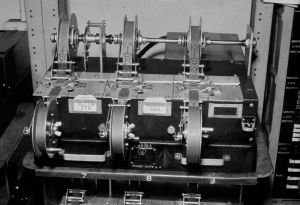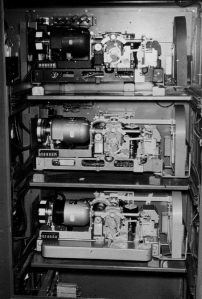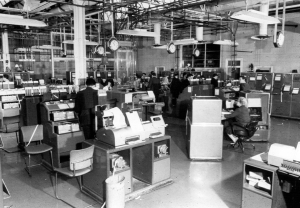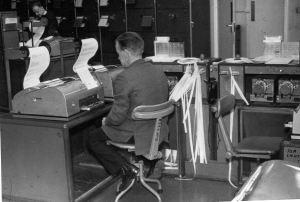I’m grateful to Colin McKeeman from the Republic of Ireland for the first three photos. Colin is an enthusiastic researcher into aeronautical HF radio operations. Colin clarified for me that “Birdlip was the receiving station, whereas Winstone was its associated transmitter site, both operating concurrently. Ballygirreen took over Birdlip’s role on the North Atlantic on the 13th January 1966 and so the HF R/T NARTEL station at Birdlip was closed.”
thanks Colin
I’ve also had a comment from Jonathan Williams (thanks Jonathan) about the CACC that says
“The original Communications Centre was at Croydon (no date but 1945 photo is available) with a new CACC (Civil Aviation Communications Centre) opening there on 19.2.53. The CACC transferred to Heathrow Airport on 16.8.75 and on 7.6.08 to Swanwick Centre. Therefore the photos which are not of Birdlip will be of Croydon in the 60s.”
This photo is annotated as being the radio room at Birdlip and has the names of those present. It gives some clues to the interior appearance of Birdlip with the open framed inverted V roof.
BC3 is the aerial farm at Winstone.

BC3a front entrance to Winstone after TX wing removed

BC3b Birdlip before the new building was added
Now two photos from Alan Dodson, a couple of new photos of Birdlip staff

BC3c l to r Brian Rees, Andrew Andrews , Pete Johnson, Eric Svensen, Paul Luck, Dennis????, Tony Laers

BC3d l to r Brian Rees, Tony Lavers, Eric Svensen, Dennis????, Pete Johnson and Paul Lucvk
…………………………………………………………………..
The following photos were all taken on 14th July 1964. There are 23 photos out of a series of 36 (or more). Half the pictures were wrapped in a sheet of tissue paper with Birdlip written on it in pencil. The remainder were also wrapped in a sheet of tissue paper with CACC written on it but unfortunately the CACC was hidden by a crumpled fold and by the time we saw it we had lost the distinction between the two.
Once (with you, the viewers help) we make some progress on which are CACC photos we’ll separate the two sets of photos and issue a new post on either Birdlip or the CACC. We’ve added a b? or c? next to the photo numbers below where the location is unclear as a first guess as to whether its Birdlip or the CACC. Please puzzle away with us or, if you know, let us know too.
Two of our readers, Ron Edwards (a former STPO) and Colin McKeeman have been working to sort out the photos we have of Birdlip and the CACC. Ron has provided us with some interim guidance notes that hopefully will inform you the viewers/readers as to which photo is which building.
Ron has been able to identify many of the photos taken at Croydon CACC. Inside the CACC there was a RTTY (Radio Teletype) Section adjoining the Teleprinter Section at Croydon Airport. (RTTY is the grandfather of texting and datalink – atchistory). They were working in the same room with only a screen separating them and Ron is confident that a few of the photos are of that section.
A study of the building’s structure shows that Croydon had an open ceiling (or no ceiling at all just the roof of the building) so any unknown/unidentified photos with an open ceiling are probably of the RTTY Section. Ron says they were quite glad of the open ceiling giving extra height, because it got quite warm particularly on a summer evening and night, when they were dealing with 20,000 to 25,000 or more messages a day. He seems to remember (but don’t hold Ron to it) Christmas Day dropped to only 8,000 to 10,000!
Ron says that the photos with a proper ceiling cannot have been taken at Croydon, but he noticed that the identified Birdlip photos did have a reasonable ceiling.
Ron also reminds us of the Greetings cards compiled, sent and printed out using RTTY. Every Tower and Briefing office had a few on the wall at Christmas. So texting a graphic is not so new after all.

The character above is a British cartoon character called Andy Capp. If you’ve never read the Daily Mirror newspaper, or are not from these “Sceptred Isles”, here is more about Andy Capp
Colin McKeeman studied the content of the picture above and managed to read most of the punched tape that is visible on the automatic transmission unit. Working from left to right:-
The first circuit, on machine #7, is to Uxbridge, on the ZTB channel, and the tape confirms this as “…353 (5 spaces) ZCZC(space) ZTB354…”
The second circuit (machine #8) is to Frankfurt AFTN Centre, on channel GDA and the tape reads “…225 (5 spaces) ZCZC (space) GDA226 (5 spaces) ZCZC (space) GDA227…”
The final circuit (machine #9) is possibly to Prestwick, on the YPA channel, as the tape reads “…YPA003 (5 spaces) ZCZCYPA004…”
These all appear to be transmission sequence number checks, to verify that the circuit is working, without any actual traffic being passed.
Colin McKeeman also had a look at the picture above. The display board shows all the circuit ID’s and their associate ICAO location codes, which is confirmed in the lower section of this blackboard, showing that on the 9th July 1963, any traffic for Birdlip (EGGB) on circuits ‘A’, ‘N’, ‘OA’, ‘OP’, ‘R’, ‘V’ and ‘W’ are to be relayed via Gander (CYQX). Also at the time this photograph was taken, 298 service messages had been sent from this station that day. These SVC’s seek information or verification concerning other messages which appear to have been transmitted incorrectly over the ATFN, confirming channel-number’s, etc. I assume the 30,012 refers to the total number of messages handled so far on that date.
Winstone transmitter station
Image BC25 is at Birdlip – it’s a bank of HR91 receiver’s, the RHS set covering the Kano circuit in Bay 10, with a ‘Standby’ set beside it in Bay 11, Lisbon in Bay 12 and the Karachi circuit in Bay 13. Colin McKeeman
Winstone, the Birdlip transmitter station.
NEW we’ve received a photo archive of Birdlip from Rob Staley.
John & Nancy Ash at Birdlip.
John had started his working life aged 14 as a plumber’s mate and living in a tent by the Gloucester docks. He then volunteered for the Army when he was only 16 and just left the tent where it was! Nancy’s first job before joining the WAAF was a chambermaid. So quite impressive careers from modest beginnings. These photos and documents are from a collection left by Nancy Ash (nee Allen) who worked at Birdlip immediately post war. Nancy had volunteered for the WAAF in October ’41 and was trained as a teletype operator. It is unclear if she was posted to Birdlip while still in the WAAF or whether she moved there after she was demobbed. While she was at Birdlip she met and married John Ash. John had been in signals during the war and moved to Birdlip after he was demobbed from India in 1947.
John said that his job at Birdlip was to use Morse code to make initial contact with aircraft as they crossed the Atlantic.
The first 4 photos seem to be official and are marked on the back “Crown copyright” & “Copyright Cheltenham News Company”.

John said this chap was a friend of his. A close study of the rack behind reveals that the 2nd unit from the top is a power unit type 234A. Below it are two receivers, type R1392D. Presumably this equipment was used to optimise the signal from distant aircraft to assist Johns communication?

John is seated to the right and rear of the photo.

Nancy is on the right.

Group photo, date unknown. John is middle row, 2nd from the right. Nancy is not in the photo.




Thought to be the winter of’47. Snow had blocked the road so Nancy and colleagues had to walk to work across the fields. There is another nice picture somewhere of them pushing a lorry up the hill, but it has gone AWOL!

John with his wartime signals unit.
During her time with the WAAF Nancy kept an impressive journal recording technical information and procedures that must have continued to be relevant at Birdlip. The images show a page from her journal plus various documents that were folded into the journal.








Nancy left Birdlip in the early fifties to have their first child.
John stayed at Birdlip longer, then moved to Gatwick, working nightshifts as an air traffic controller. After a serious crash occurred during the shift before his, he decided to move into equipment engineering and maintenance at Gatwick and Heathrow. He then moved to Bletchley Park, teaching equipment technicians. He retired in the mid-eighties.




























Does anyone have any more photos of BC1 and its area?
LikeLike
As I was only at Birdlip and Winstone BC6,8,9,x10,11,12,13,14,15 ARE NOT FAMILIAR TO ME.. However BC22 could be the control desk at the end of the eqpt rm with a printer link to Winstone and an GEC400 RX for beacon monitoring. B,C24 could be the NARTEL position, late days at Birdlip, but should only have 3 teleprinters not 4 in front of the lady. so doubtful this one.BC26 no question , a Marconi DS13, watercooled 40Kw TX with 5Kw drive unit door open.. BC27 could be the Aerial amplifiers and changeover unit in eqpt Rm Birdlip
LikeLike
Hi Alan, if possible I would be delighted to hear from you off-line at my address banterops@icloud.com about your time at Birdlip/Winstone. My research on both stations is almost complete but I am always delighted to hear from any staff who worked at either location. Thanks and regards, Colin
LikeLike
OK Colin , you have my e-mail add, do you want me to reply to banterops@icloud.com ?
LikeLike
Another one, BC7 is at Winstone.
Regards, Colin
LikeLike
BC7 Looks like a marconi DS12 with modulator
LikeLike
Hi John,
Image BC25 is at Birdlip – it’s a bank of HR91 receiver’s, the RHS set covering the Kano circuit in Bay 10, with a ‘Standby’ set beside it in Bay 11, Lisbon in Bay 12 and the Karachi circuit in Bay 13.
Regards, Colin
LikeLike
all previous comments now included in the post above
LikeLike